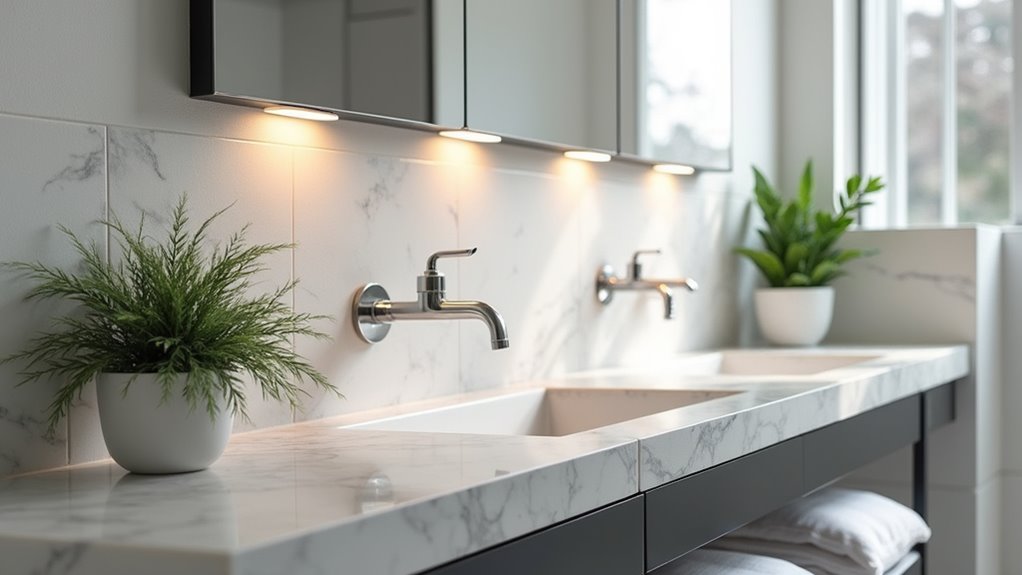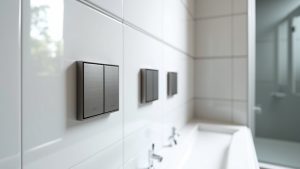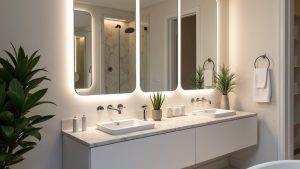To achieve the perfect bathroom wall light height, start by placing sconces at 60 to 65 inches for eye-level illumination. Consider alternative fixtures such as pendants or LED mirrors for added sophistication. Maintain a spacing of 36 to 40 inches between sconces, while accounting for user height adjustments. Position lights above mirrors at 75 to 80 inches, ensuring compliance with safety standards. Explore these considerations further to create an inviting and functional bathroom atmosphere.
Key Takeaways
- Position wall sconces 60 to 65 inches from the floor for optimal eye-level lighting while ensuring reduced glare and unflattering shadows.
- Align the bottoms of sconce shades slightly below eye level when flanking mirrors to enhance face lighting and create an inviting atmosphere.
- Install fixtures above mirrors at 75 to 80 inches from the floor, with lights 6 to 8 inches above the mirror for even illumination.
- Mount sconces 36 to 40 inches apart, positioning each 18 inches from the sink’s centerline for balanced light distribution.
- Adjust light fixture heights based on primary user heights, considering the needs of all household members for maximum safety and usability.
Understand Optimal Eye-Level Placement

How can one achieve the perfect balance of light and aesthetics in a bathroom? Understanding optimal eye-level placement for wall sconces is essential.
Positioning fixtures between 60 to 65 inches from the floor ensures that light sources are near eye level, offering various eye level benefits. This setup minimizes harsh lighting glare and shadows, providing even illumination essential for grooming tasks like shaving or makeup application. Consulting a qualified electrician can ensure that electrical wiring and installations are performed safely and up to code standards. Additionally, when sconces flank a mirror, their height helps create balanced lighting across the face, enhancing features without unflattering shadows. Ensuring the bottom of the sconce shades align slightly below eye level contributes to an inviting ambiance, further enhancing both the room’s functionality and visual appeal. Backlit mirrors, which feature dimmable LED lights, can also aid in adjusting light levels for various bathroom activities. Furthermore, it’s important to consider spacing and balance when installing multiple wall lights to achieve optimal results. Proper sconce placement not only improves overall bathroom functionality but also elevates the aesthetic of the space.
Explore Alternatives for Eye-Level Range

While traditional wall sconces positioned at eye level remain a popular choice for bathroom lighting, there are numerous alternatives that can achieve both style and functionality.
Pendant alternatives, when used in spacious bathrooms, can introduce sophistication while providing effective illumination. Ideally, these fixtures should be hung 60-66 inches from the floor and spaced 30-36 inches apart for balanced light around a vanity mirror. For an energy-efficient solution, consider incorporating integrated LED technology that reduces utility costs and offers longevity.
Integrated solutions, such as LED mirrors, offer a modern approach, delivering shadowless light without the need for additional wall fixtures. Their anti-fog features and adjustable settings cater to diverse user needs.
Additionally, under-cabinet LED strip lighting can create a soft glow, enhancing the bathroom’s aesthetic while ensuring practicality in smaller spaces.
Consider Spacing Between Sconces

Beyond selecting the right fixture type, proper spacing between sconces significantly impacts both functionality and aesthetics in a bathroom.
Sconce positioning should effectively balance lighting distribution, particularly when flanking mirrors. For optimal results, mount sconces about 36 to 40 inches apart, ensuring each is positioned 18 inches from the sink’s centerline. This distance approximates shoulder width, facilitating even illumination while reducing shadows.
Additionally, maintain a clearance of 4-5 inches between the mirror’s edge and the fixtures to minimize glare and reflections. In larger setups, like double vanities, consider multiple fixtures spaced evenly for consistent lighting.
Account for User Height Adjustments

To ensure optimal lighting in a bathroom, consideration of the primary users’ heights is essential, as this allows for a more tailored and effective illumination experience. Effective wall light placement addresses user height variability, accommodating both taller and shorter individuals. Adjustable lighting options can enhance flexibility, allowing users to choose the best setting for their needs. A well-thought-out compromise height for fixtures can create a balanced and functional environment.
| User Height (inches) | Suggested Sconce Height (inches) | Notes |
|---|---|---|
| 58 – 62 | 60 – 65 | Ideal for average height users |
| 63 – 70 | 65 – 70 | Higher mounting for taller users |
| 71 – 77 | 70 – 75 | Consider overhead light angles |
| Children (under 48) | 48 – 54 | Lower placement for safety |
| Mixed heights | 60 – 70 | Compromise for shared use |
Determine the Best Height for Lights Above a Mirror

The height at which lights are mounted above a mirror plays a pivotal role in achieving effective bathroom illumination. An optimal light positioning generally suggests fixtures be placed 75 to 80 inches from the finished floor, ideally 6 to 8 inches above the mirror’s top.
Proper mirror dimensions must also be considered; taller mirrors exceeding 80 inches should have lights positioned 5 to 10 inches above them. This method ensures even light distribution, crucial for tasks like shaving or applying makeup.
Additionally, the design of the bathroom and the type of light fixture—such as bar lights—can influence final placement. The primary goal is to illuminate the face uniformly, minimizing shadows while achieving a harmonious aesthetic.
Analyze Lighting Needs and Ceiling Height

In assessing bathroom wall lighting, it is essential to factor in user height and the available ceiling space.
Tailoring the installation height of light fixtures to accommodate the average height of users ensures optimal functionality and comfort during grooming tasks.
Additionally, evaluating the ceiling height allows for strategic placement that enhances both illumination and the overall aesthetic of the space.
User Height Consideration
While considering bathroom lighting, one must take into account both user height and ceiling height to achieve optimal illumination.
Scone styles that flank mirrors should ideally align with the user’s eye level, typically between 60-66 inches, yet adjustments may be needed for taller or shorter individuals.
Lighting colors can enhance the overall ambiance, but placement is crucial; lights above mirrors should generally sit 75-80 inches from the floor to minimize shadows during grooming tasks.
For households with varying heights, flexible lighting solutions, such as adjustable sconces, can provide effective illumination.
Ultimately, prioritizing even light distribution will facilitate essential activities like makeup application and shaving, ensuring both functionality and aesthetic appeal in the bathroom space.
Ceiling Space Evaluation
How can one effectively assess the interplay of ceiling height and lighting needs in a bathroom? Evaluating ceiling style and determining appropriate fixture types are crucial steps in this process. Standard ceilings lend flexibility in wall light placement, while lower ceilings necessitate strategic adjustments to prevent a cramped environment. For high ceilings, mounting wall sconces higher is vital for proportional illumination. The following table summarizes optimal fixture heights based on ceiling height:
| Ceiling Height | Fixture Type |
|---|---|
| Standard (8 feet) | 1.6 – 1.8 meters from floor |
| Low ceilings (<8 feet) | Flush or semi-flush mounts |
| High ceilings (>9 feet) | Higher-mounted sconces |
| Sloped ceilings | Adjust based on angle/architecture |
This assessment ensures optimal bathroom lighting while enhancing aesthetic appeal.
Follow Safety and Regulatory Considerations

When planning bathroom wall lighting, understanding the designated zones and corresponding IP ratings is vital for safety.
Proper specifications must be adhered to, particularly in moisture-prone areas where fixtures require higher IP ratings to prevent potential hazards.
Compliance with these standards not only protects users but also ensures the longevity and reliability of lighting installations.
Understand Bathroom Zones
Recognizing the importance of understanding bathroom zones is crucial for ensuring safety in moisture-rich environments.
Bathroom zones classify areas based on their risk of water exposure, thereby mitigating potential bathroom hazards. Zone 0, located inside the bath or shower tray, poses the highest risk and mandates low voltage lighting not exceeding 12V.
Zone 1, extending above the bath or shower, remains a splash zone where electrical safety protocols often require RCD protection for mains voltage lights.
Zone 2, surrounding the wash basin, also exhibits moisture risk but with slightly lower danger.
To achieve compliance, a qualified electrician should handle installations, following regulations such as BS 7671 and IEC 60364-7-701, ensuring overall safety in these high-risk areas.
Choose Proper IP Ratings
Choosing the proper IP ratings for bathroom wall lights is essential to ensure safety and compliance in moisture-laden environments. The importance of an appropriate IP rating cannot be overstated, as it mitigates risks associated with moisture exposure.
When selecting fixtures, consideration should be given to:
- IP44 or higher for general bathroom areas
- IP65 or above near basins or taps
- IP67 for placements near showers or baths (though not directly above)
- Preference for higher ratings when uncertain
- Avoidance of untested fixtures, typically rated at IP20
With these guidelines, one can adequately protect against electrical hazards, ensuring both safety and longevity of lighting installations in the bathroom.




